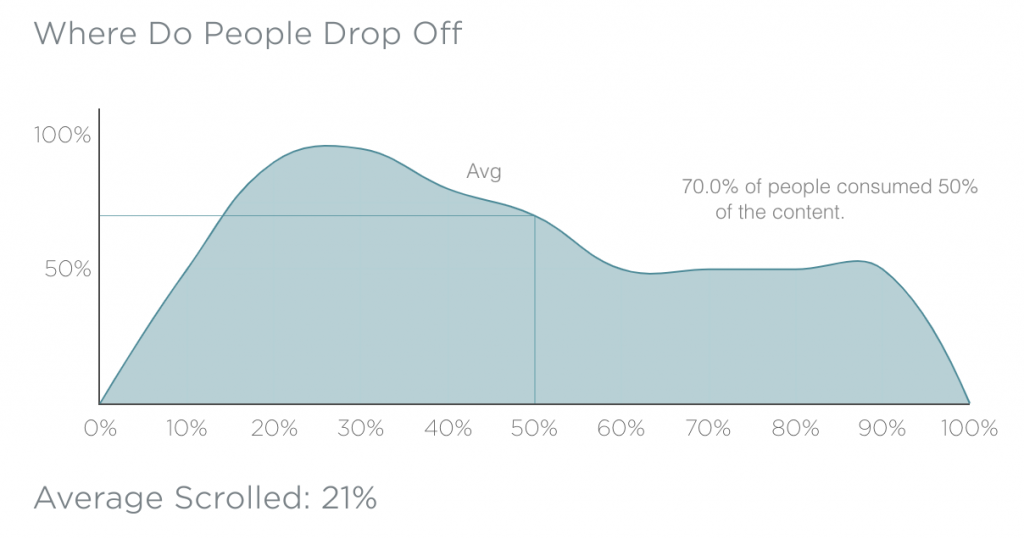Scroll depth is a metric that enables marketers to see how far customers are scrolling down a page. Scroll engagement is often expressed as scroll depth, or average scroll, both provide a feedback loop of what was in view of the customer.
This provides a third dimensional view of the engagement, a person clicked through, and here’s how much of the page they consumed.
If you are new to analyzing scroll, some recommended articles are:
- What is a scroll depth tracker?
- How to track scroll depth
- What is a good scroll depth
- What is a good scroll depth benchmark?
- How to view scroll depth in Nudge
- How can i add scroll depth tracking in WordPress with Nudge?
- How to compare scroll depth on page vs site average
- How to analyze content using scroll depth
- Why do you track Scroll Depth?
- Factors which Drive Content ROI
Why is scroll depth important?
Scroll depth shows how engaging a webpage is. Because customers are telling the companies through their actions by scrolling down. They are scrolling through the page, consuming it or looking for something to help.
This then as a feedback loop is invaluable. Without scroll data, companies would be in the dark as to how good their experience really is.
This is useful for:
- Seeing how engaging a webpage or piece of content is
- Identifying the quality of traffic
- Identifying areas of improvement
- Figuring out the ideal place to put calls to action
An example is, a company was looking at their average scroll and found that users weren’t scrolling that far, which surprised them. When they looked the webpage, it had a delayed video, which expanded at the top of the screen. This stopped people engaging, as they quickly left the page.
Without scroll data, telling them there was a problem, they would not have been able to address this.
Example of scroll metrics in action

How does scroll tracking work?
A piece of javascript is installed on the webpage. This then is able to talk to the browser and understand which part of the webpage is in view.
Then analytics can overlay that data against other variables it collects, such as traffic source, geography, time of day, device, the URL. To paint a high fidelity view of what variables are driving the most engagement.
This data can then be viewed in an online dashboard.
What about the opposite, scroll drop off?
Platforms like Nudge show you both. They show you the average scroll and how many people scroll to a specific point. They also show you where customers drop off. This is equally important. As if there are elements on the page, stopping people from engaging, they should be addressed. Or it can help see how well internal links are performing.
An example is, a brand was exploring why they had such a high bounce rate, so they looked at where people were dropping off, and identified an auto expanding part of the page, which was driving visitors away. Once they removed this their bounce rate dropped and their average scroll increased.
Using scroll metrics as a KPI for traffic
Identifying what happens post click is a valuable exercise in demonstrating the ROI of pay per click or any traffic acquisition plan. Scroll metrics help qualify how well traffic sources are doing.
If you have one traffic source that is driving 20% average scroll and another that is driving 40%, you might want to investigate why that might be.
Factors like targeting, creative, audience and even quality of traffic can be an issue causing this.
Average Scroll and Branded Content
Average scroll is often used as a KPI for branded content & native advertising campaigns. Success for these types of campaigns, means consumption of the content. So scroll helps to establish that – and whether it happened or not.
Scroll data can also be used to help validate creative strategies or help in the content sign off process, taking a particular decision may impact the average scroll of content. Armed with that data, stakeholders can make decisions about those trade offs.
For example, including multiple calls to action in a piece of content, creates more exit points. Which may reduce the average scroll but in term increase the brand metrics and conversion metrics. This may not always be necessarily true, as the calls to action can provide exit points for low engaged users. Which is why brands need to be attentive to the performance of their content and the objectives of the campaign.
In publishing environments where ‘infinite scroll’ is part of the experience, this can inflate the average scroll metrics, and should be examined further. Other metrics may be more insightful in these use cases.
..

|
|---|



